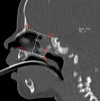Skull Base Anatomy in Patients with Bilateral Choanal Atresia: A Radiographic Study
- PMID: 35769795
- PMCID: PMC9236707
- DOI: 10.1055/s-0040-1722230
Skull Base Anatomy in Patients with Bilateral Choanal Atresia: A Radiographic Study
Abstract
Introduction The risk of skull base injury during choanal atresia repair can be mitigated via thorough understanding of skull base anatomy. There is a paucity of data describing differences in skull base anatomy between patients with coloboma, heart defects, atresia choanae, growth retardation, genital abnormalities, and ear abnormalities (CHARGE) syndrome and those without. Objectives The aim of this study was to measure nasal and skull base anatomy in patients with isolated bilateral choanal atresia (BCA), CHARGE syndrome, and other syndromic congenital anomalies. Methods Retrospective chart review of patients with bilateral choanal atresia and computed tomography of the face between 2001 and 2019 were evaluated. Choanal width, height, mid-nasal height, and skull base slope were measured radiographically. Differences in anatomy between healthy patients, those with CHARGE syndrome, and those with other congenital anomalies were compared. Results Twenty-one patients with BCA and relevant imaging were identified: 7 with isolated BCA, 6 with CHARGE syndrome, and 8 with other congenital anomalies. A t -test indicated insignificant difference in skull base slope, choanal height, choanal width, or mid-nasal skull base height between isolate BCA cases and patients with any congenital anomaly. When comparing CHARGE to isolated BCA cases, mid-nasal height was shorter in CHARGE patients ( p = 0.03). There were no differences in measurements between patients with congenital anomalies excluding CHARGE ( p > 0.05). Two patients in the congenital anomaly group were found to have bony skull base defects preoperatively. Conclusion This study represents the largest description of skull base and nasal anatomy in patients with CHARGE syndrome and BCA. Surgeons should be aware of the lower skull base in CHARGE patients to avoid inadvertent skull base injury.
Keywords: CHARGE; choanal atresia; skull base anatomy.
Thieme. All rights reserved.
Conflict of interest statement
Conflict of Interest None declared.
Figures
References
-
- Harris J, Robert E, Källén B. Epidemiology of choanal atresia with special reference to the CHARGE association. Pediatrics. 1997;99(03):363–367. - PubMed
-
- Ramsden J D, Campisi P, Forte V. Choanal atresia and choanal stenosis. Otolaryngol Clin North Am. 2009;42(02):339–352. - PubMed
-
- Moreddu E, Rizzi M, Adil E. International Pediatric Otolaryngology Group (IPOG) consensus recommendations: diagnosis, pre-operative, operative and post-operative pediatric choanal atresia care. Int J Pediatr Otorhinolaryngol. 2019;123:151–155. - PubMed
-
- Leclerc J E, Fearon B. Choanal atresia and associated anomalies. Int J Pediatr Otorhinolaryngol. 1987;13(03):265–272. - PubMed
-
- Meleca J B, Anne S, Hopkins B. Reducing the need for general anesthesia in the repair of choanal atresia with steroid-eluting stents: a case series. Int J Pediatr Otorhinolaryngol. 2019;118:185–187. - PubMed



